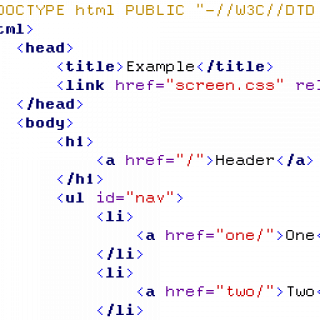HTML (Hypertext Markup Language) is a formatting or markup language used to create documents for the World Wide Web.
What is Hypertext Markup Language?
A formatting or markup language used to create documents for the World Wide Web (WWW). It can be complemented by technologies such as Cascading Style Sheets (CSS) and scripting languages such as JavaScript.

What is HTML? (from W3.org)
HTML is the Web’s core language for creating content for everyone to use anywhere.
How it works
Hypertext Markup Language (HTML) in its simplest form uses tags to format ASCII text documents by indicating text that should be displayed as boldface, italic, bulleted, hyperlinked, centered, and so on. These tags usually come in pairs, can be nested, can contain additional attributes, and are used to “mark up” the text. For example, the text “Save 50%” can be displayed on Web browsers in boldface by marking it up using the <STRONG> tag (which means “turn on the bold style”) and the </STRONG> tag (which means “turn off the bold style”). The resulting HTML would look like this:
<STRONG>Save 50%</STRONG>
HTML pages are saved as files with the extension .htm or .html in the appropriate directory on a Web server such as Microsoft Internet Information Services (IIS). When a Web browser such as Microsoft Internet Explorer downloads an HTML page from a Web server, it interprets the tags and displays the document with the appropriate formatting.
HTML has gone through several versions since it was created in the early 1990s. At the time of this writing, the most current version is HTML 4. The original HTML did not provide much control over how documents were formatted – that is, how objects such as text and graphics were laid out on a page. Its original set of tags was quite limited and was intended primarily for linking documents using hyperlinks to form hypertext.
As the Web grew in popularity, however, first Netscape and then Microsoft introduced their own proprietary HTML tags to provide Web developers with more control over document formatting, thus increasing the pace at which the World Wide Web Consortium (W3C) developed the HTML standard. HTML 4 includes standards for creating cascading style sheets, which provides powerful formatting capabilities for precise placement of objects on a Web page.
Hypertext Markup Language History
In 1980, physicist Tim Berners-Lee, a contractor at CERN, proposed and prototyped ENQUIRE, a system for CERN researchers to use and share documents. In 1989, Berners-Lee wrote a memo proposing an Internet-based hypertext system. Berners-Lee specified HTML and wrote the browser and server software in late 1990. That year, Berners-Lee and CERN data systems engineer Robert Cailliau collaborated on a joint request for funding, but the project was not formally adopted by CERN. In his personal notes from 1990 he listed “some of the many areas in which hypertext is used” and put an encyclopedia first.
The first publicly available description of HTML was a document called “HTML Tags”, first mentioned on the Internet by Tim Berners-Lee in late 1991. It describes 18 elements comprising the initial, relatively simple design of HTML. Except for the hyperlink tag, these were strongly influenced by SGMLguid, an in-house Standard Generalized Markup Language (SGML)-based documentation format at CERN. Eleven of these elements still exist in HTML 4.
See also: Anchor Text (HTML)